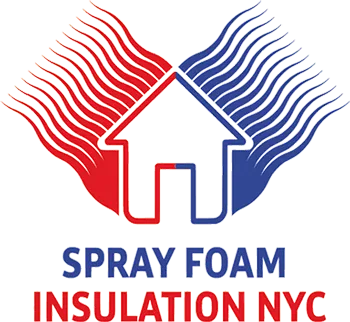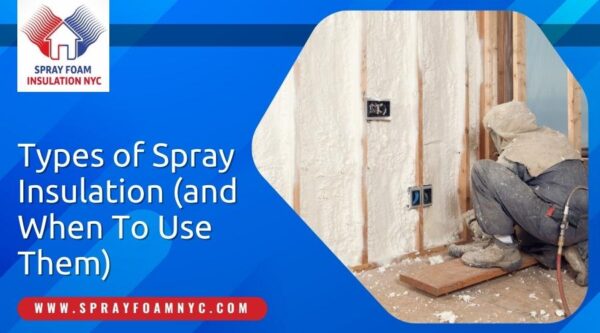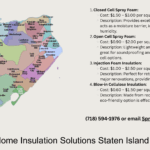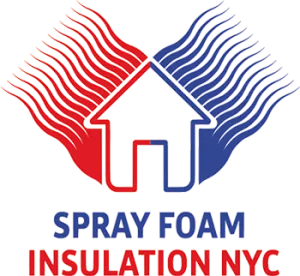Spray insulation is a versatile and effective solution for improving the energy efficiency of buildings. There are several types of spray insulation available, each with its unique properties and applications. In this article, we will explore the different types of spray insulation and when to use them.
Types of Spray Insulation
- Closed-Cell Spray Foam Insulation
Commonly used in attics, walls, and crawl spaces, this is a popular choice due to its excellent insulation capabilities. It is made by mixing two components, which react and expand when sprayed onto a surface. The resulting foam is rigid and has a high R-value, making it ideal for areas that require a high level of insulation. It also acts as an effective moisture barrier and provides structural support to the building. - Open-Cell Spray Foam Insulation
Possessing a different cellular structure than closed-cell foam with a lower R-value compared to its counterpart, open-cell spray insulation may not be as effective in extreme climates. It is softer and less dense, which allows for better sound absorption. This is an excellent choice for interior walls and ceilings where noise reduction is a priority. - Fiberglass Spray Insulation
Fiberglass spray insulation is composed of tiny glass fibers mixed with a binding agent. When sprayed onto a surface, it forms a thick layer of insulation. Fiberglass insulation is known for its affordability and ease of installation. It is commonly used in walls, attics, and floors. However, it is important to note that fiberglass insulation can cause skin and respiratory irritation, so proper protective gear should be worn during installation. - Cellulose Spray Insulation
Cellulose spray insulation is made from recycled paper and treated with fire retardants. It is an environmentally friendly option that offers good thermal and sound insulation properties. Cellulose insulation is often used in attics and wall cavities. It is important to ensure proper installation to prevent settling and maintain its effectiveness. - Polyurethane Spray Insulation
Polyurethane spray insulation is a type of foam insulation that provides excellent thermal insulation properties. It is sprayed as a liquid and expands to fill cavities, creating an airtight seal. Polyurethane insulation is commonly used in walls, roofs, and basements. It provides superior insulation and helps reduce energy costs. However, it can be more expensive compared to other types of spray insulation.
When to Use Different Types of Spray Insulation

Choosing the right type of spray insulation depends on various factors, including the climate, building design, cost of spray insulation installation, as well as the budget you have available. Here are some guidelines for when to use different types of spray insulation:
- Closed-cell spray foam insulation: Used in areas that require high insulation performance, such as attics, walls, and crawl spaces. It is also suitable for areas prone to moisture intrusion.
- Open-cell spray foam insulation: Ideal for interior walls and ceilings where noise reduction is desired. It is less effective in extreme climates, which is perhaps why it is considered the most affordable spray foam application of all options
- Fiberglass spray insulation: An affordable option for walls, attics, and floors. Take necessary precautions during installation to avoid irritation.
- Cellulose spray insulation: Environmentally friendly choice for attics and wall cavities. Proper cellulose spray insulation installation is crucial to maintain its effectiveness.
- Polyurethane spray insulation: Provides superior thermal insulation and is suitable for walls, roofs, and basements. It may bei a pricier option.
Spray Foam Insulation NYC Offers Varied Types of Spray Insulation
If you are in New York City and looking for spray insulation solutions, you’re in luck! Spray Foam Insulation NYC offers a wide range of options to meet your specific needs. Whether you require closed-cell foam for high insulation performance or open-cell foam for noise reduction, you can find the right solution for your project. With professional installation services available, you can ensure a quality insulation job that improves energy efficiency and comfort in your building.

FAQs
Is spray insulation suitable for both residential and commercial buildings?
Yes, spray insulation can be used in both residential and commercial buildings. It offers effective insulation for various structures, regardless of size.
Can I install spray insulation myself, or do I need professional help?
While some types of spray insulation may be available in DIY kits, it is generally recommended to seek professional help for proper installation. This ensures optimal performance and safety.
How long does spray insulation last?
Spray insulation is designed to be long-lasting. With proper installation and maintenance, it can last for several decades, providing ongoing energy savings.
Is spray insulation environmentally friendly?
Some types of spray insulation, such as cellulose and polyurethane, are considered environmentally friendly due to their recycled or low-emission materials. However, it is important to consider the specific product and its environmental certifications.
Can spray insulation help reduce energy costs?
Yes, spray insulation is known for its energy-saving properties. By improving the building’s insulation, it helps reduce heat loss or gain, resulting in lower energy consumption and cost savings over time.
In conclusion, spray insulation offers a range of options for enhancing the energy efficiency and comfort of buildings. Whether you choose closed-cell foam, open-cell foam, fiberglass, cellulose, or polyurethane, each type has its unique benefits and applications. By selecting the right spray insulation for your needs and seeking professional installation, you can enjoy the advantages of improved insulation and reduced energy costs in your home or commercial space.












